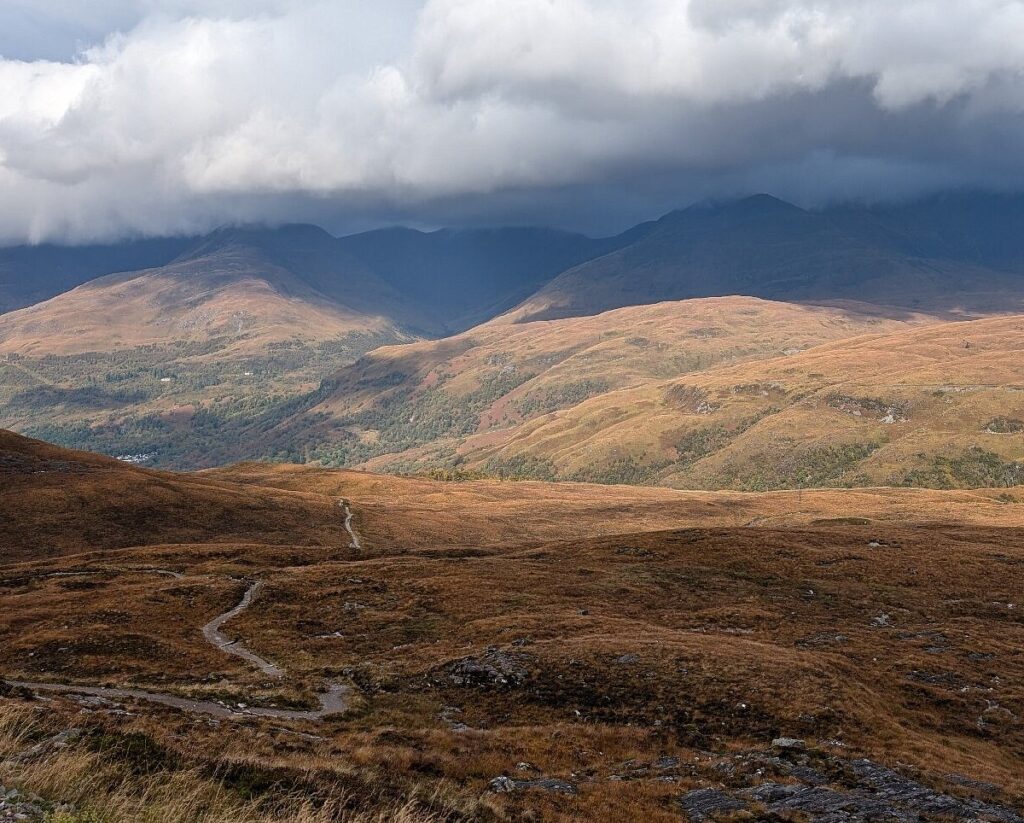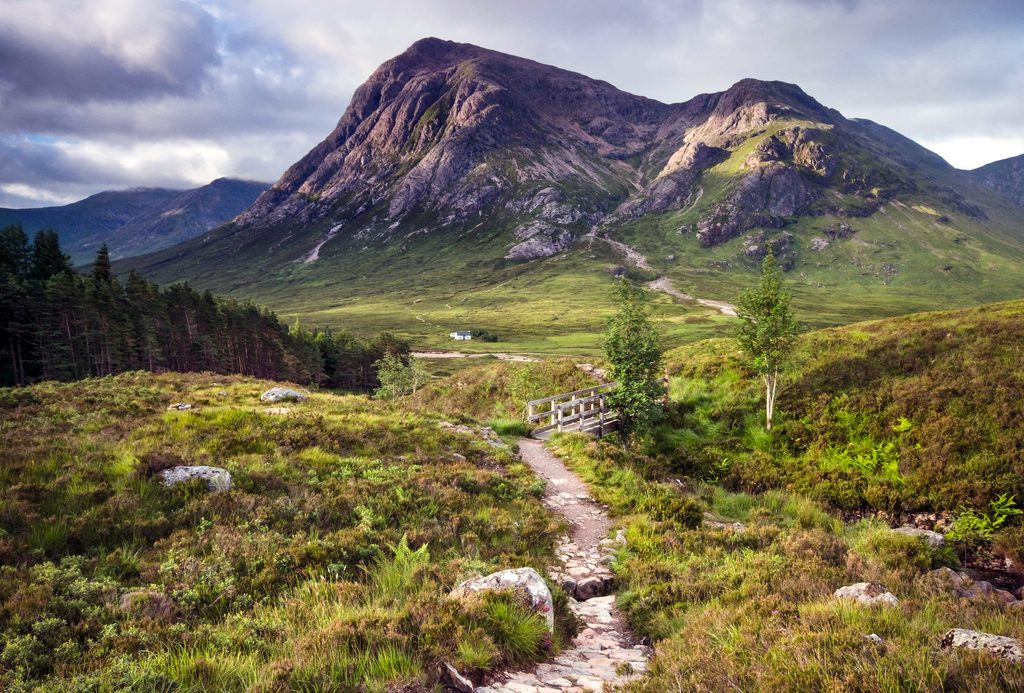The Devil’s Staircase is one of the most iconic and challenging routes in the Scottish Highlands, located in the heart of Glencoe. Known for its dramatic ascent, breathtaking views, and rugged terrain, it attracts hikers, climbers, and outdoor enthusiasts from around the world. The name itself evokes a sense of foreboding, hinting at both the physical difficulty of the climb and the formidable landscape that surrounds it. The route, steeped in history and natural beauty, is a testament to the wild and untamed character of the Highlands.

Geographical Context
The Devil’s Staircase is situated within the Glencoe valley, an area shaped by glacial activity and renowned for its dramatic mountainous scenery. Glencoe lies in the Lochaber region of the Scottish Highlands, where towering peaks, deep valleys, and fast-flowing rivers create one of Scotland’s most spectacular landscapes. The route itself is part of the West Highland Way, a long-distance trail stretching from Milngavie near Glasgow to Fort William, and it serves as one of the most memorable sections for walkers completing the route.
The name “Devil’s Staircase” likely originates from both the steep, almost vertical nature of the ascent and the challenging conditions encountered along the trail. The staircase begins near Kinlochleven, a village at the base of the Mamores mountains, and ascends through a series of rugged slopes and rocky outcrops to reach higher ground. The elevation gain is substantial, and the trail often presents steep, uneven paths that require careful footing, particularly in wet or icy conditions.
Historical Significance
The Devil’s Staircase is not only a natural feature but also a site of historical importance. During the 18th and 19th centuries, this route was part of the military road network built by General George Wade and his successors to improve access to the Highlands following the Jacobite uprisings. The roads were designed to allow government troops to move quickly through the region, providing both strategic advantage and control over a historically rebellious area. The Devil’s Staircase remains a testament to these engineering efforts, though nature has reclaimed much of the route, leaving hikers to traverse rugged, unpaved paths that test endurance and skill.
The surrounding Glencoe area carries a broader historical resonance, most famously as the site of the Glencoe Massacre of 1692. While the Devil’s Staircase itself was not directly involved in the events of the massacre, the trail passes through landscapes that were intimately tied to Highland history, connecting hikers to centuries of human stories, clan struggles, and military campaigns.
Hiking Experience
For modern visitors, the Devil’s Staircase is primarily known as a challenging hiking route. The trail is demanding due to its steep gradient, rocky terrain, and variable weather conditions. Hikers must be prepared for sudden changes in weather, as mist, rain, and wind are common, even in summer. The climb requires physical stamina, appropriate footwear, and navigation skills, especially for those attempting the ascent in poor visibility.
Despite its difficulty, the Devil’s Staircase offers unparalleled rewards. From the higher sections of the trail, hikers are treated to panoramic views of the surrounding mountains, valleys, and lochs. The combination of steep ascents, dramatic ridges, and expansive vistas makes the route a favorite among photographers and outdoor enthusiasts seeking both challenge and natural beauty. During winter months, snow and ice add an extra layer of complexity, attracting experienced mountaineers and ice climbers to test their skills in a Highland setting.
The Devil’s Staircase also serves as a connector for other notable hiking destinations in Glencoe. It links to trails leading to peaks such as Bidean nam Bian, the highest mountain in the area, and the Pap of Glencoe, offering opportunities for extended hikes and multi-day adventures. Many walkers combine the Devil’s Staircase with the West Highland Way, making it one of the most memorable segments of the long-distance route.
Ecological Significance
The Devil’s Staircase is set within a diverse and ecologically rich environment. The ascent traverses upland heath, montane grasslands, and rocky outcrops, providing habitat for a range of flora and fauna. The high-altitude environment is home to hardy plants adapted to exposure, wind, and poor soils, including alpine mosses, heather, and dwarf willow. These plant communities are crucial for soil stabilization and ecosystem health in a landscape prone to erosion and harsh weather.
Wildlife is also a significant aspect of the Devil’s Staircase experience. Hikers may spot red deer grazing on the slopes, mountain hares leaping among rocks, and birds of prey such as golden eagles and peregrine falcons soaring overhead. Smaller birds, including ptarmigan and meadow pipits, thrive in the montane habitat, while invertebrates, lichens, and mosses contribute to the intricate web of life in the highlands. The trail provides an opportunity for ecological observation and appreciation, demonstrating the resilience and diversity of life in extreme environments.
Safety and Preparation
Given the challenging nature of the Devil’s Staircase, preparation is essential. Hikers should be physically fit, equipped with sturdy boots, weather-appropriate clothing, maps or GPS devices, and sufficient food and water. The trail can be treacherous in wet, icy, or windy conditions, and inexperienced walkers should take care, particularly on exposed ridges. Awareness of local weather patterns and potential hazards is crucial, as Highland weather can change rapidly, with mist, rain, and wind creating visibility and footing challenges.
Many guided walks and organized groups include the Devil’s Staircase as part of longer excursions, offering safety and support for those less familiar with the terrain. However, solo or independent walkers can also enjoy the route, provided they respect its challenges and take appropriate precautions.
Cultural and Literary Significance
The Devil’s Staircase, like the wider Glencoe area, has captured the imagination of artists, writers, and outdoor enthusiasts. Its dramatic ascent and panoramic views have been depicted in paintings, photographs, and travel literature, symbolizing the wild and untamed character of the Scottish Highlands. The trail embodies themes of endurance, challenge, and connection to nature, making it a symbol of personal achievement for hikers who complete the ascent.
The name itself—“Devil’s Staircase”—evokes both awe and caution, reflecting the psychological impact of steep, rugged terrain and the longstanding association of mountains and wilderness with danger, mystery, and adventure. Folklore and local stories further enrich the cultural resonance of the area, linking the landscape to the broader narrative of Highland history, clan identity, and human interaction with nature.
Tourism and Economic Impact
The Devil’s Staircase contributes significantly to tourism in Glencoe and the wider Lochaber region. Hikers, climbers, and photographers visiting the route support local businesses, including accommodation providers, cafes, outdoor equipment shops, and guiding services. The trail’s inclusion in the West Highland Way adds to its popularity, as long-distance walkers seek to complete the full route, experiencing the Devil’s Staircase as one of its most memorable segments.
Tourism associated with the Devil’s Staircase encourages conservation and sustainable management of the surrounding environment. By attracting visitors interested in nature, hiking, and cultural history, the trail supports awareness and appreciation of Scotland’s natural and historical heritage, fostering a sense of responsibility for the preservation of fragile Highland ecosystems.
Conservation and Environmental Considerations
Managing the Devil’s Staircase presents challenges due to its popularity, steep terrain, and sensitive ecology. Erosion from foot traffic, habitat disturbance, and the impact of weather conditions require careful maintenance and management. Local authorities and conservation organizations implement measures such as path reinforcement, signage, and habitat restoration to minimize environmental impact while allowing safe access for visitors.
The surrounding area, including the broader Glencoe valley and nearby National Nature Reserves, is managed to balance recreation with conservation. Protection of wildlife habitats, monitoring of plant communities, and control of invasive species are essential components of maintaining the ecological integrity of the Devil’s Staircase and its surroundings.
Conclusion
The Devil’s Staircase in Glencoe is more than just a challenging hiking route; it is a symbol of the Scottish Highlands’ wild beauty, historical depth, and ecological richness. Its steep ascent, dramatic vistas, and rugged terrain test physical endurance while offering profound rewards in terms of scenic appreciation, wildlife observation, and connection to Highland history. From its origins as part of a military road network to its current status as a celebrated hiking trail, the Devil’s Staircase embodies the intersection of human history, natural wonder, and outdoor adventure.
Visitors to the trail experience not only the physical challenge of the climb but also the psychological and emotional impact of traversing one of Scotland’s most iconic landscapes. The combination of natural beauty, ecological significance, and historical resonance makes the Devil’s Staircase a unique destination within Glencoe, attracting walkers, climbers, and nature enthusiasts year-round.
In essence, the Devil’s Staircase stands as a testament to the ruggedness, resilience, and majesty of the Scottish Highlands. It offers an immersive experience in nature, a connection to centuries of history, and a challenge that rewards both perseverance and curiosity. For those who undertake its climb, the Devil’s Staircase is a journey through landscape, history, and personal achievement—a true emblem of Highland adventure.

